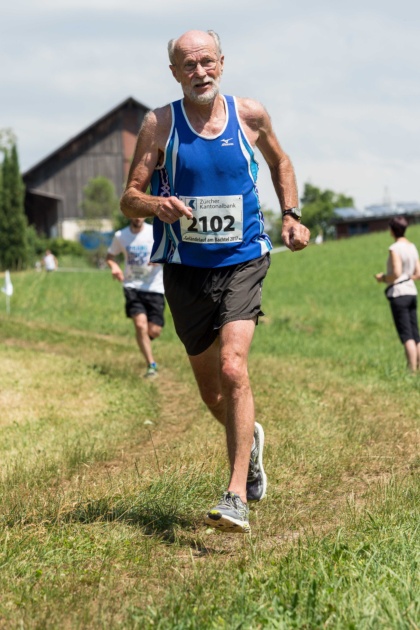
Interview with Albert Anderegg
At over 70 years old, Albert Anderegg is still running circles around many young, ambitious runners. Hailing from the Bernese Highlands, he is a multiple-time European and world champion among seniors on the track, in cross-country running, and on the street, and he's not nearly ready to quit.
In your view, what are the keys to successfully running without health problems for as long as you have?
My varied training is most certainly one key. I'm referring to, for instance, switching between very slow and very intense workouts, from very flat laps around the track to very steep mountain runs, very short and very long distances (from 1,500 metres to marathon). Besides running, varied training means also engaging in mountain biking, cross-country skiing, snowshoeing, and so forth.
A quite varied diet, including a daily glass of wine, is part of my regime, but I don’t use a special nutrition plan.
My experience as a junior track and field athlete long ago also plays a major role. As I learned at the time, I'm very consistent about my warm-up and cool-down runs, and continue practising them today, contrary to (too) many of my colleagues.
Furthermore, I have learned to listen to my body, whereby “free of health problems” is perhaps not quite the right expression. When you test your limits in terms of athletic performance, you discover where such boundaries lie. That's why it is important for me to recognise early on when I'm overstraining myself in order to quickly step down the intensity and scope to below my limits.
In what areas do even you feel the effects of ageing? What adjustments have you had to make?
Compared to my competitors, I have always participated in relatively few competitions. In recent years, my desire to compete has diminished even further.
What's more, over time, I've successively reduced the scope of my workouts slightly. For example, this year, I noticed a more long-lasting effect through interval workouts with 2 series each instead of 3. This way, I was able to complete the individual runs more quickly and further step up the pace from series to series.
A few years ago, I was still able to run close to, or even over my limit from the get-go during competitions and pick off one competitor after the next throughout the entire race. Nowadays, it is more worthwhile for me to start off at a slower pace and maintain a reserve, enabling me to pick up speed in the course of the competition.
Can you explain to us your training principles and describe an example training week?
From October to February, I strive for a proper basic workout by going on long mountain bike excursions, long jogs, snowboarding tours, and so forth. Workout is the wrong word, though – because for me, it's pure pleasure. Your head benefits from this phase at least as much as your body!
In the spring, I just need a few proper weeks of training, as described below, to get back into action.
Example training week:
Monday
Very intense interval: 3 series of 125m+250m+500m+1000m+500m+250m+125m each with 1-minute breaks between runs and 3-minute breaks between series (if no access to track, then on a marked, flat, and low-traffic asphalt side street).
Tuesday
1 hour of very slow endurance running along mountain trails.
Wednesday
1 hour of intermediate-pace endurance running or round of mountain biking at 800 metres of altitude or break.
Thursday
1 hour of intermediate-pace endurance running on nature trails as easy-going fartlek.
Friday
Intense mountain run of approximately 30 minutes at 600 metres of altitude on mountain trail, leisurely run back.
Saturday
1 hour of very slow endurance running along nature trails.
Sunday
Intermediate-pace endurance run on hilly terrain.
Looking back at your long career, for one thing, you didn't miss a single one of the 36 Bern Grand Prix runs! What has changed for you in recent years?
My 36 results from 1982 to 2017, aside from the extreme outliers (collarbone break, etc.), paint a very interesting picture when illustrated on a graph – the curve basically shifts three minutes downwards from one Grand Prix to the next since my retirement. In the 6 editions between 1996 and 2001, my Grand Prix time rose successively from 56.37 to 59.39 minutes. After retirement, it dropped again to 56.21 minutes (2003), to subsequently rise continually in the 9 following ones to 60.30 minutes (2012). I attribute the 3-minute shifts primarily to the very different recuperation conditions that I had as a retiree.
The result is that under certain circumstances (available time), it makes much more sense to invest time in recuperation rather than in more training.
Do you have a secret tip to share with us? A key workout, diet, or technique tip, for instance?
Although I've run the entire spectrum of competitive and training runs, from 1,500 metres to Alpine marathons, I've particularly concentrated on relatively short stretches throughout the years, at around 10 km. My base speed has always been very important to me and I have just as much fun during the very tough interval workouts as during 3-hour-long jogs along the Gommer Höhenweg trail.
At the same time, I participate in relatively few competitions. But those that I do, I do with full concentration, as well as proper preparation and motivation. This means for me setting priorities not only in training, but also in my selection of competitions.
Foto: ZVG
Many thanks to Albert Anderegg for the interesting answers.
This may be of interest for you too


